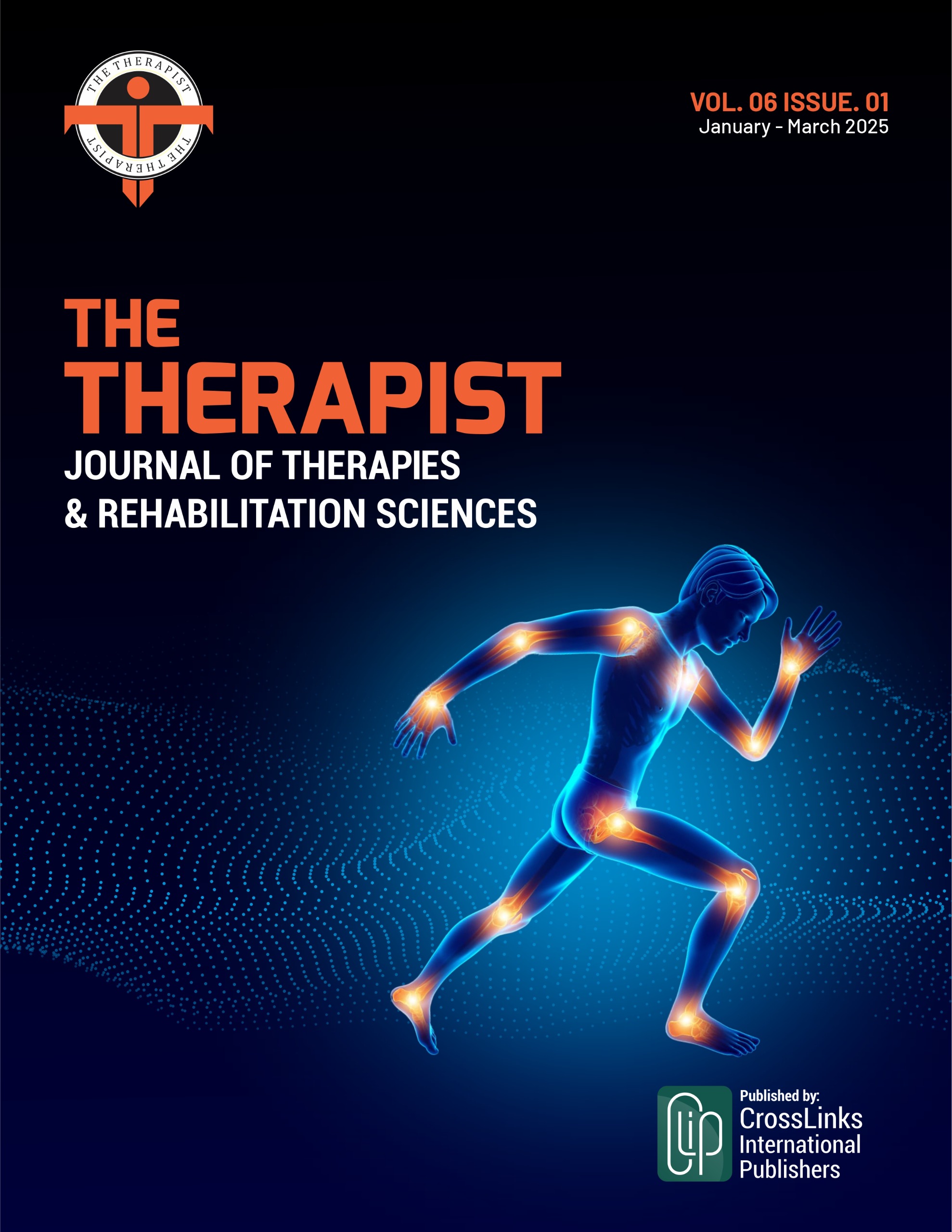The Prevalence of Core Muscles Weakness and Fatigue in 18-to 25-Year-Old Medical College Students
Prevalence of Core Muscles Weakness and Fatigue
DOI:
https://doi.org/10.54393/tt.v6i1.246Keywords:
Core Muscle Weakness, Mcgill Core Endurance Test, Rating of Fatigue Scale, GenderAbstract
Core muscles play a significant role in the stability of the back spine, ribcage, and lumbopelvic region by influencing daily living activities and balance. Objectives: To investigate core muscles weakness among male and female medical college students aged 18-25 and to evaluate their core muscle endurance using the McGill core endurance tests. Also, to assess fatigue levels among participants using the Rating of Fatigue Scale (ROF). Methods: A total of 246 participants were recruited from Rashid Latif Medical College (RLMC) and Johar Institute of Professional Studies (JIPS), Lahore, using non-probability convenient sampling. The sample size was determined using Epitool software. To assess core muscle endurance, the McGill Core Endurance Test was administered. Additionally, the Rating of Fatigue Scale was used to evaluate fatigue levels among participants. Data were entered and analyzed using SPSS version 27.0. Numeric data are presented as mean and standard deviation. Results: 92.68% of participants exhibited core muscles weakness during the 60º Spinal Flexion Test, and 96.75% of participants exhibited core muscles weakness during the Side Plank Tests. Another Rating of fatigue is a prevalent issue among the participants, with only 10.2% reporting no fatigue. The majority of participants (43.5%) experienced mild fatigue, while a significant proportion (37%) reported moderate fatigue. Furthermore, 8.5% of participants experienced severe fatigue, and 0.8% reported the worst fatigue. Conclusions: It was concluded that a remarkably high prevalence of core muscles weakness was found among medical college students. Furthermore, failure to engage core muscles during daily activities likely contributes to this prevalent weakness.
References
Saki F, Shafiee H, Tahayori B, Ramezani F. The Effects of Core Stabilization Exercises On the Neuromuscular Function of Athletes with ACL Reconstruction. Scientific Reports. 2023 Feb; 13(1): 2202. doi: 10.1038/s41598-023-29126-6.
Shalamzari MH, Henteh MA, Shamsoddini A, Ghanjal A. Comparison of the Effects of Core Stability and Whole-Body Electromyostimulation Exercises On Lumbar Lordosis Angle and Dynamic Balance of Sedentary People with Hyperlordosis: A Randomized Controlled Trial. BioMed Central Sports Science, Medicine and Rehabilitation. 2024 Apr; 16(1): 91. doi: 10.1186/s13102-024-00879-5.
Øverås CK, Nilsen TI, Nicholl BI, Rughani G, Wood K, Søgaard K et al. Multimorbidity and Co-Occurring Musculoskeletal Pain Do Not Modify the Effect of the SELFBACK App on Low Back Pain-Related Disability. BioMed Central Medicine. 2022 Feb; 20(1): 53. doi: 10.1186/s12916-022-02237-z.
Behera P, Majumdar A, Verma M, Kumarasamy AP, Mishra N. Musculoskeletal Pain Affecting Undergraduate Nursing Students: A Cross Sectional Study On the Prevalence and the Associated Factors. Journal of Professional Nursing. 2023 Nov; 49: 135-44. doi: 10.1016/j.profnurs.2023.09.012.
Devries MC and Giangregorio L. Using the Specificity and Overload Principles to Prevent Sarcopenia, Falls and Fractures with Exercise. Bone. 2023 Jan; 166: 116573. doi: 10.1016/j.bone.2022.116573.
Alshehri MM, Alqhtani AM, Gharawi SH, Sharahily RA, Fathi WA, Alnamy SG et al. Prevalence of Lower Back Pain and Its Associations with Lifestyle Behaviors Among College Students in Saudi Arabia. BioMed Central Musculoskeletal Disorders. 2023 Aug; 24(1): 646. doi: 10.1186/s12891-023-06683-5.
Rakholiya P, Mistry I, Patel R, Tank P, Sonpal D. Prevalence Core Muscle Weakness in 18–25 Years Old Females. International Journal of Advanced Researche. 2021; 7(9): 37-40.
Hooker DN and Prentice WE. Rehabilitation of Injuries to the Spine. In Rehabilitation Techniques for Sports Medicine and Athletic Training. 2024 Jun: 785-840. doi: 10.4324/9781003526308-28.
Meyers WC and Editor. Introducing the Core: Demystifying the Body of an Athlete. Taylor and Francis. 2024 Jun. doi: 10.4324/9781003524670.
Esteban-García P, Jiménez-Díaz JF, Abián-Vicén J, Bravo-Sánchez A, Rubio-Arias JÁ. Effect of 12 Weeks Core Training On Core Muscle Performance in Rhythmic Gymnastics. Biology. 2021 Nov; 10(11): 1210. doi: 10.3390/biology10111210.
Norris C. Back Rehabilitation: Core Stability Re-examined. Routledge. 2023 Jul. doi: 10.4324/9781003366188.
Palmer TG and McCabe M. The Effect of a Novel Weight-Supported Kinetic Chain Resistance Training Program on Proximal Core Muscular Endurance, Trunk to-Arm Muscular Power, and Bat Swing Speed. The Journal of Strength and Conditioning Research. 2023 Nov; 37(11): 2130-40. doi: 10.1519/JSC.0000000000004520.
Nam-guk S. Comparison of the Effects Of 12-Week Online-Delivered Isometric and Dynamic Core Stability Exercises On Functional Movement, Dynamic Postural Control, and Core Endurance in Healthy Young Adults. 2022.
Karaçay BÇ and Konar NM. Risk Factors for Reduced Core Endurance, Fatigue and Physical Inactivity in Medical Students. Anatolian Clinic Journal of Medical Sciences. 2023 May; 28(2): 139-48. doi: 10.21673/anadoluklin.1165830.
Ghorbani M, Yaali R, Sadeghi H, Koumantakis GA. The Impact of Flatfeet on the Correlation Between Functional Movement Scores, Balance, Agility, and Core Muscle Strength in Young Females: A Cross-Sectional Study. Scientific Reports. 2025 Feb; 15(1): 5077. doi: 10.1038/s41598-025-89364-8.
Lusk CB. The Impact of Stability Exercises on Core Muscle Imbalances and Subsequent Low Back Pain. Auburn University. 2021.
Oliva-Lozano JM and Muyor JM. Core Muscle Activity During Physical Fitness Exercises: A Systematic Review. International Journal of Environmental Research and Public Health. 2020 Jun; 17(12): 4306. doi: 10.3390/ijerph17124306.
Bhore PR, Bathia K, Kanase S, Jadhav A. Prevalence of Core Weakness in Bank Employees. Journal of Clinical and Diagnostic Research. 2019 Mar; 13(3). doi: 10.7860/JCDR/2019/40155.12697.
McGill S. Core Training: Evidence Translating to Better Performance and Injury Prevention. Strength and Conditioning Journal. 2010 Jun; 32(3): 33-46. doi: 10.1519/SSC.0b013e3181df4521.
Micklewright D, St Clair Gibson A, Gladwell V, Al Salman AJ. Development and Validity of the Rating-of-Fatigue Scale. Sports Medicine. 2017 Nov; 47: 2375-93. doi: 10.1007/s40279-017-0711-5.
Akduman V, Özay ZG, Sarı Z, Polat MG. Is There A Relationship Between Physical Activity Level and Core Endurance?. Kocaeli Üniversitesi Sağlık Bilimleri Dergisi. 2019 Nov; 5(2): 60-5. doi: 10.30934/kusbed.478109.
Priyadarshini S and Gopalswami AD. Efficacy of Core Musculature Strengthening on Postural Sway. Journal of Clinical and Diagnostic Research. 2019 Jul; 13(7). doi: 10.7860/JCDR/2019/34644.12995.
Sarac DC, Bayram S, Tore NG, Sari F, Guler AA, Tufan A et al. Association of Core Muscle Endurance Times with Balance, Fatigue, Physical Activity Level, and Kyphosis Angle in Patients with Ankylosing Spondylitis. Journal of Clinical Rheumatology. 2022 Jan; 28(1): e135-40. doi: 10.1097/RHU.0000000000001641.
Fallahasady E, Rahmanloo N, Seidi F, Rajabi R, Bayattork M. The Relationship Between Core Muscle Endurance and Functional Movement Screen Scores in Females with Lumbar Hyperlordosis: A Cross-Sectional Study. BioMed Central Sports Science, Medicine and Rehabilitation. 2022 Oct; 14(1): 182. doi: 10.1186/s13102-022-00567-2.
Abhilash P, Priya S, Kheriwala MK. Correlation Between Static Balance and Core Endurance Among College Student with Forward Head Posture. International Journal of Science and Healthcare Research. 2021; 6: 244-50. doi: 10.52403/ijshr.20210742.
Esfahani NH, Dommerholt J, Rezaeian ZS. Core Muscles Endurance in Sedentary Staffs with and without Nonspecific Chronic Low Back: A Cross-sectional Study. Muscles, Ligaments and Tendons Journal. 2021 Jan; 11(1). doi: 10.32098/mltj.01.2021.15.
Kapre TM and Alexander JO. A Correlation Study of Weak Core Muscles with Hamstring Muscles Flexibility in Young Adults. Bulletin of Faculty of Physical Therapy. 2024 Nov; 29(1): 79. doi: 10.1186/s43161-024-00244-0.
Downloads
Published
How to Cite
Issue
Section
License
Copyright (c) 2025 THE THERAPIST (Journal of Therapies & Rehabilitation Sciences)

This work is licensed under a Creative Commons Attribution 4.0 International License.
This is an open-access journal and all the published articles / items are distributed under the terms of the Creative Commons Attribution License, which permits unrestricted use, distribution, and reproduction in any medium, provided the original author and source are credited. For comments editor@thetherapist.com.pk










